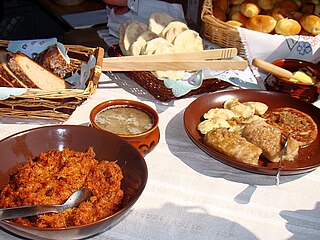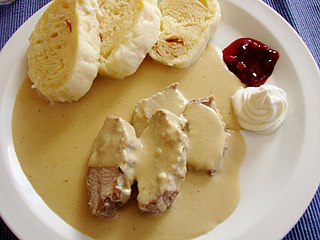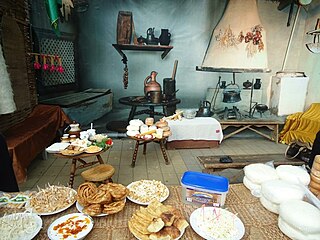
Turkish cuisine is the cuisine of Turkey and the Turkish diaspora. Although the cuisine took its current rich form after numerous cultural interactions throughout centuries, it should not be confused with other cuisines such as Ottoman cuisine or Seljuk cuisine. Turkish cuisine with traditional Turkic elements such as yogurt, ayran, kaymak, exerts and gains many influences to and from Greek, Armenian, Mediterranean, Balkan, Middle Eastern, Central Asian and Eastern European cuisines.

Polish cuisine is a style of food preparation originating in and widely popular in Poland. Due to Poland's history, Polish cuisine has evolved over the centuries to be very eclectic, and shares many similarities with other national cuisines. Polish cooking in other cultures is often referred to as à la polonaise.
Romanian cuisine is a diverse blend of different dishes from several traditions with which it has come into contact, but it also maintains its own character. It has been influenced mainly by Turkish but also a series of European cuisines in particular from the Balkan Peninsula and Hungarian cuisine as well as culinary elements stemming from the cuisines of Central Europe.

Czech cuisine has both influenced and been influenced by the cuisines of surrounding countries and nations. Many of the cakes and pastries that are popular in Central Europe originated within the Czech lands. Contemporary Czech cuisine is more meat-based than in previous periods; the current abundance of farmable meat has enriched its presence in regional cuisine. Traditionally, meat has been reserved for once-weekly consumption, typically on weekends.

Levantine cuisine is the traditional cuisine of the Levant, in the sense of the rough area of former Ottoman Syria. The cuisine has similarities with Egyptian cuisine, North African cuisine and Ottoman cuisine. It is particularly known for its meze spreads of hot and cold dishes, most notably among them ful medames, hummus, tabbouleh and baba ghanoush, accompanied by bread.
Kurdish cuisine consists of a wide variety of foods prepared by the Kurdish people. There are cultural similarities of Kurds and their immediate neighbours in Iran, Iraq, Turkey, Syria, and Armenia. Kurdish food is typical of western Asian cuisine.

Tatar cuisine is primarily the cuisine of the Volga Tatars, who live in Tatarstan, Russia, and surrounding areas.
Bosnian cuisine is the traditional cuisine of Bosnia and Herzegovina. It is influenced by Ottoman, Austro-Hungarian and Balkan cuisines.

Georgian cuisine consists of cooking traditions, techniques, and practices of Georgia. Georgian cuisine has a distinct character, while bearing some similarities with various national cuisines of the South Caucasus, the Middle East and Eastern Europe. Every region of Georgia has its own distinct style of food preparation. Eating and drinking are important parts of Georgian culture.

Chitrali cuisine refers to the food and cuisine of the Chitrali people from the northern region of the Khyber Pakhtunkhwa province of Pakistan and the bordering Nuristan province in Afghanistan. Chitrali food has a regional variance in contrast to many other cuisines of Pakistan. The food of Chitral is very similar to the cuisine in neighboring Gilgit-Baltistan.

Circassian cuisine is an ethnic cuisine, based on the cooking style and traditions of the Circassian people of the North Caucasus. This region lies between the Black Sea and the Caspian Sea, within European Russia.

Dumpling is a broad class of dishes that consist of pieces of cooked dough, often wrapped around a filling. The dough can be based on bread, wheat or other flours, or potatoes, and it may be filled with meat, fish, tofu, cheese, vegetables, or a combination. Dumplings may be prepared using a variety of cooking methods and are found in many world cuisines.
Chechen cuisine is the traditional folk cuisine of the Chechen people, who dwell in the North Caucasus.

Arab Indonesian cuisine is characterized by the mixture of Middle Eastern cuisine with local Indonesian-style cuisine. Arab Indonesians brought their legacy of Arab cuisine—originally from Hadhramaut, Hejaz, Sudan and Egypt—and modified some of the dishes with the addition of Indonesian ingredients. The Arabs arrived in the Nusantara archipelago to trade and spread Islam. In Java, since the 18th century AD, most of Arab traders settled on the north coast and diffuse with indigenous, thus affecting the local cuisine culture, especially in the use of goat and mutton meat as well as ghee in cooking.

Pontic Greek cuisine consists of foods traditionally eaten by Pontic Greeks, a Greek-speaking ethnic minority that originates from the southern shore of the Black Sea in modern Turkey. Their cuisine has been heavily influenced by the migration of different ethnic groups to the Pontos. Because of the Pontos' remote location, Pontic Greek cuisine has many differences from other Greek cuisines. According to Achillefs Keramaris et al., "Pontic Greek traditional cuisine is diverse and simplistic, incorporating traditions from mountainous and coastal regions, ancient Greece, nomadic regions, and influences from Russian, Turkish, Laz, Hemshin, and Armenian cuisines."
































